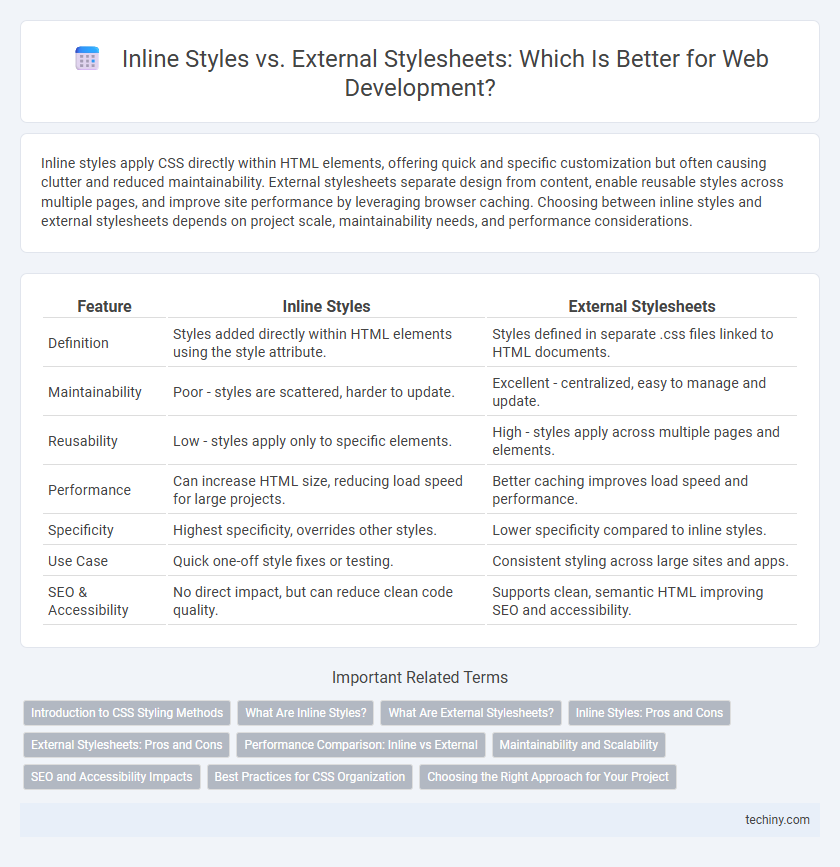Inline styles apply CSS directly within HTML elements, offering quick and specific customization but often causing clutter and reduced maintainability. External stylesheets separate design from content, enable reusable styles across multiple pages, and improve site performance by leveraging browser caching. Choosing between inline styles and external stylesheets depends on project scale, maintainability needs, and performance considerations.
Table of Comparison
| Feature | Inline Styles | External Stylesheets |
|---|---|---|
| Definition | Styles added directly within HTML elements using the style attribute. | Styles defined in separate .css files linked to HTML documents. |
| Maintainability | Poor - styles are scattered, harder to update. | Excellent - centralized, easy to manage and update. |
| Reusability | Low - styles apply only to specific elements. | High - styles apply across multiple pages and elements. |
| Performance | Can increase HTML size, reducing load speed for large projects. | Better caching improves load speed and performance. |
| Specificity | Highest specificity, overrides other styles. | Lower specificity compared to inline styles. |
| Use Case | Quick one-off style fixes or testing. | Consistent styling across large sites and apps. |
| SEO & Accessibility | No direct impact, but can reduce clean code quality. | Supports clean, semantic HTML improving SEO and accessibility. |
Introduction to CSS Styling Methods
Inline styles apply CSS directly within HTML elements using the style attribute, offering quick, localized customization but limited reusability and maintainability. External stylesheets store CSS rules in separate .css files, enabling consistent styling across multiple webpages and improving site performance through browser caching. Choosing between inline styles and external stylesheets depends on project scale, with external stylesheets preferred for larger, scalable websites to ensure cleaner code and easier updates.
What Are Inline Styles?
Inline styles are CSS declarations applied directly within HTML elements using the style attribute, allowing for immediate and specific styling of individual tags. They override external and internal stylesheet rules due to their high specificity, making them useful for quick, element-specific design changes. However, inline styles can reduce code maintainability and scalability compared to external stylesheets, which centralize styling across multiple pages.
What Are External Stylesheets?
External stylesheets are separate CSS files linked to an HTML document using the tag, enabling centralized control of web page styles. They promote faster page loading by allowing browsers to cache CSS files and enhance maintainability through reusable code across multiple pages. Using external stylesheets also improves scalability and keeps the HTML structure clean by separating content from presentation.
Inline Styles: Pros and Cons
Inline styles provide immediate application of CSS directly within HTML elements, enabling rapid testing and quick adjustments for specific components without modifying separate files. They offer higher specificity, which can override external or internal styles, but this advantage often leads to challenges in maintainability, readability, and scalability as projects grow. Relying heavily on inline styles increases code duplication, hinders separation of concerns, and complicates global style updates across web applications.
External Stylesheets: Pros and Cons
External stylesheets enhance website maintainability by allowing centralized CSS management for multiple pages, improving loading speed through browser caching and reducing HTML file size. They promote consistent design across a site and facilitate easier updates without modifying HTML files directly. However, external stylesheets can increase initial load time due to an additional HTTP request and may cause styling issues if the stylesheet fails to load or is improperly linked.
Performance Comparison: Inline vs External
Inline styles apply CSS directly within HTML elements, resulting in faster initial rendering since the browser doesn't need to fetch separate files. External stylesheets improve overall performance by enabling browser caching, reducing repeated downloads across multiple pages. Choosing external stylesheets enhances maintainability and scalability, especially for large websites, while inline styles can slow page loading when overused due to increased HTML size.
Maintainability and Scalability
Inline styles hinder maintainability by embedding CSS directly within HTML elements, making updates tedious and error-prone as the project grows. External stylesheets centralize CSS rules, enabling streamlined modifications and consistent styling across multiple pages, which enhances scalability for expanding websites. Utilizing external stylesheets promotes cleaner code architecture and easier collaboration among development teams.
SEO and Accessibility Impacts
Inline styles hinder SEO by embedding CSS directly within HTML elements, reducing code readability and making it harder for search engines to parse content effectively. External stylesheets improve website accessibility by allowing consistent styling across pages and faster load times, enhancing user experience for assistive technologies. Leveraging external CSS contributes positively to SEO rankings by promoting cleaner HTML structure and enabling better crawlability and maintainability.
Best Practices for CSS Organization
Using external stylesheets is a best practice for CSS organization because it separates content from design, improves maintainability, and enables caching for faster load times. Inline styles should be minimized as they increase code redundancy and make global updates cumbersome. Well-structured external CSS files with clear naming conventions and modular components enhance scalability and collaboration among development teams.
Choosing the Right Approach for Your Project
Inline styles provide quick, specific customization ideal for small-scale projects or urgent fixes, but they complicate maintenance and scalability in larger applications. External stylesheets enhance organization, promote reusability, and improve load times through caching, making them the preferred choice for complex, multi-page websites. Developers should balance project size, maintainability, and performance needs when deciding between inline styles and external stylesheets.
Inline Styles vs External Stylesheets Infographic

 techiny.com
techiny.com